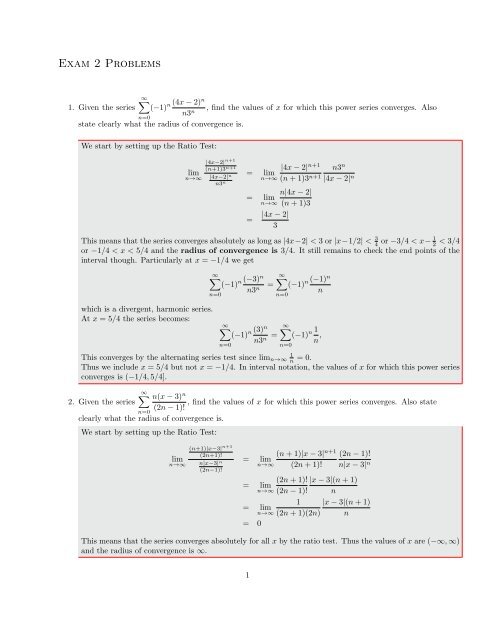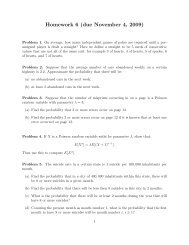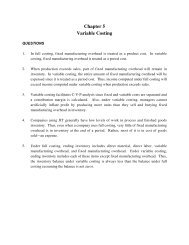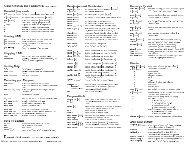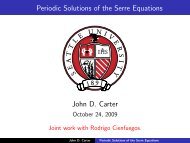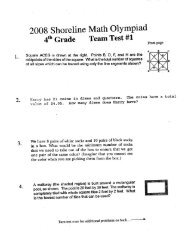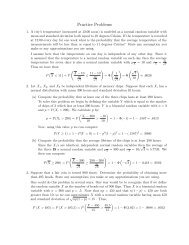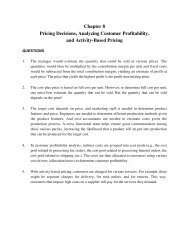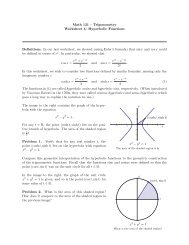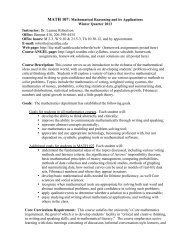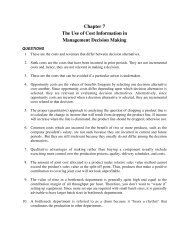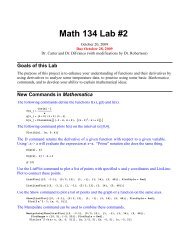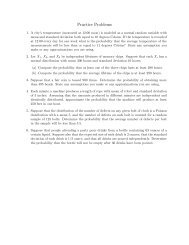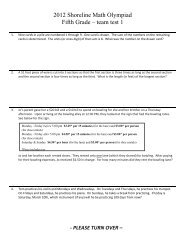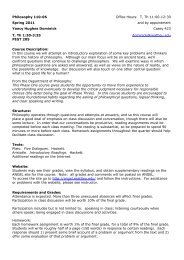Practice Problems Exam 2 Solutions
Practice Problems Exam 2 Solutions
Practice Problems Exam 2 Solutions
Create successful ePaper yourself
Turn your PDF publications into a flip-book with our unique Google optimized e-Paper software.
(f)√ ∞∑ n!n=12 nFirst we note that since this is a series with positive terms then either the series converges absolutely or itdiverges. We then check the ratio test giving,(g)limn→∞√(n+1)!2√ n+1= limn!n→∞2 n= limn→∞√(n + 1)!√n!2 n2 n+1√ n + 1= ∞2Thus by the ratio test, the series diverges. You could also make an argument why the terms do not go tozero and thus is divergent by the divergence test.∞∑n=1e 1 nn 2Again since the terms are positive, conditional convergence is not an option. Looking at this series we coulduse the comparison test with the convergent p-series ∑ 1n. Either you could use the regular comparison test2and recognize that,.e 1 nn 2 ≤ e n 2and since ∑ enis a convergent p-series, then the original series must also converge.2You could also use the limit comparison test and compute the limit:limn→∞e 1 nn 21n 2= limn→∞ e 1 n = e 0 = 1Since this is a finite limit that is greater than 0, then by the limit comparison test either both series convergeor both diverge and since ∑ 1nis a convergent p-series, then the original series must also converge.25
6. Use the Maclaurin series for sin(x) to compute a Maclaurin series for F (x) which satisfies,∫ ( )sin x2F (x) =dx, F (0) = 23xWe begin with the Maclaurin series for sin(x) which is:∞∑sin(x) = (−1) n x2n+1(2n + 1)! = x − x33! + x55! − x77! + . . . , R = ∞n=0Thus,Thus,Thus,sin ( x 2) =∞∑(−1) n x4n+2(2n + 1)! = x2 − x63! + x105!n=0− x147!+ . . . , R = ∞sin ( x 2) ∞∑= (−1) n x4n+1x(2n + 1)! = x − x53! + x95! − x13+ . . . , R = ∞7!n=0F (x) =∫ ( )sin x2 ∞∑∫dx = C + (−1) n x4n+1x(2n + 1)! dxn=0=∞∑C + (−1) n x 4n+2(4n + 2)(2n + 1)!n=0= C + x22 − x66(3!) + x1010(5!) − x1414(7!) + . . . , R = ∞Now since F (0) = 23, then C = 23 and we have the Mclaurin series for F (x) is given by,F (x) = 23 +and has an infinite radius of convergence.∞∑(−1) n x 4n+2(4n + 2)(2n + 1)!n=07
8. True or False: Decide if each of the following statements are true or false, and discuss briefly why.(a) If limn→∞ a n = 0, then∞∑a n converges.n=1This is false, this statement is only true in the special case of alternating series with decreasing terms. A∞∑ 1counter example to this statement is that the harmonic series has terms that go to zero, but the sumnn=1does not converge.∞∑(b) If a power series c n (x − 2) n converges at x = 5 but diverges at x = 7 then it must convergen=0at x = 1.This is true, the implication is that the radius of convergence is at least 3 but no more than 5, this impliesthat the series must converge for |x − 2| < 3, must diverge for |x − 2| > 5 and without more information wedon’t know what happens for 3 < |x − 2| < 5. The value x = 1 though is in the first case, and thus the seriesmust converge here.(c) If the partial sum s 5 =k=1bounded above by the integral5∑∞1(−2) k is used to approximate s = ∑ 1(−2) k then the error |s − s 5| is∫ ∞51(−2) x dx.This is false, the statement that is given is the bound that is used for functions that converge via the integraltest. The conditions needed to apply this bound are that the terms are positive, the function is decreasingafter some point, and that the corresponding function is continuous. The first requirement, that the termsare positive, is not satisfied here so we can’t apply this bound. There is a bound though in this case and itwould be given by b n+1 = b 6 = 1 2 6 , by the error bound for alternating series.k=19
√1210. Compute the limit below by using a Taylor series forx− 11 centered at a = 1.limx→1(√12x − 11 )− 1x − 1You should only need the first three terms of the series.First let us write out the first 3 terms of the Taylor series:f (n) (x) f (n) (0) f (n) (0)/n!f(x) =√12x− 11 f(1) = 1 1f ′ (x) =−12x−22 √ 12x −11 f ′ (1) = −12/2 -6f ′′ (x) =12(9−11x)( 12 −11) 3 2x x 4f ′′ (1) = 12(−2)1− 242 = −12This gives that the series is of the form:√12/x − 11 = 1 − 6(x − 1) − 12(x − 1) 2 + . . .So( √12/x− 11)− 1x − 1= −6 − 12(x − 1) + . . .Consequently, the limit we seek is −6 since all of the terms involving (x − 1) go to 0 as x → 1.11


